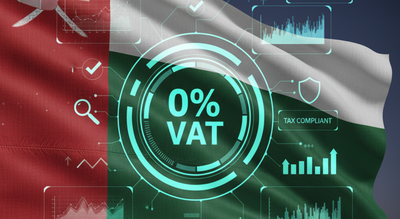
Oman clarifies VAT rules for imports from UAE and GCC, simplifying refunds, reducing costs, and boosting cross-border trade efficiency / Illustrative AI-generated image
Omani businesses importing goods from the UAE can finally stop losing precious cash flow to double taxation. On October 13, 2025, the Oman Tax Authority (OTA) issued a crucial public clarification outlining a definitive 3-point master plan to simplify cross-border trade, immediately zero-rate UAE imports, and guarantee the swift recovery of any mistakenly paid 5% Value Added Tax (VAT).
This move targets a major logistical and financial headache for VAT-registered Omani traders, providing two distinct pathways to recovery and one powerful strategy to ensure 0% VAT is applied at the point of sale.
The day the double tax burden ended: OTA's crucial clarification
Cross-border trade between Oman and the UAE has long suffered from a persistent problem: double taxation. Omani companies registered for VAT often paid the standard 5% UAE VAT when buying goods, only to face delays and administrative hurdles recovering that tax after importing the goods back into Oman.
This tied up working capital and increased costs. On October 13, 2025, the Oman Tax Authority (OTA) stepped in with a definitive public clarification.
The announcement targeted Omani companies registered under the VAT system trading with the UAE and other GCC states that apply VAT. The OTA's stated goal was clear: streamline VAT procedures, prevent undue tax costs, and strengthen trade cooperation within the Gulf.
The clarification confirmed that the solution lies in treating the trade correctly from the start. It established three official mechanisms for Omani businesses to ensure their imports are effectively tax-neutral, thus putting an end to the confusion and the financial burden of double payment.
Master plan point 1: The 0% gold standard for import zero-rating
The best solution is avoidance. This point allows Omani companies to ensure the UAE supplier does not charge any VAT in the first place, thus protecting cash flow from day one.
The Overseas Supply Export Rule:
- Coordinate with the Supplier: The Omani company must proactively instruct its UAE supplier to treat the sale of goods shipped directly to Oman as a zero-rated "overseas supply export" from the UAE’s perspective.
- Immediate 0% VAT: By classifying the transaction this way, the UAE supplier is legally permitted to apply a 0% VAT rate to the invoice.
- Proof is Key: To justify the zero-rating, the UAE supplier must secure and submit the correct export documentation, most critically a UAE Export Declaration, in compliance with UAE tax regulations. This document serves as definitive proof that the goods left the UAE market.
This process ensures the Omani company receives the goods without incurring the 5% charge, making the transaction immediately tax-efficient.
Master plan point 2: The quick refund via supplier credit note
If the 5% VAT was mistakenly or unavoidably paid to the UAE supplier at the time of purchase, this is the quickest route to recovering the funds.
The Credit Note Mechanism:
- Verify Export: The Omani company must ensure the goods have been successfully exported and that the UAE supplier has the required UAE Export Declaration (the same document needed for the 0% rate).
- Issue Credit Note: Once the supplier verifies the export, they are required to issue a Credit Note to the Omani company.
- Direct Refund: The Credit Note adjusts the original invoice amount and ensures the VAT is refunded directly by the UAE supplier back to the Omani buyer.
This mechanism simplifies the refund process, making it a direct business-to-business transaction rather than a lengthy government claim.
Master plan point 3: The direct claim via UAE FTA
In scenarios where the supplier is unable or unwilling to issue a credit note, the Omani company can bypass the supplier and approach the UAE tax authority directly.
The 'Business Visitor' Refund:
- File the Form: The Omani company can submit a direct refund application to the UAE Federal Tax Authority (FTA) using the specific 'Business Visitor VAT Refund Form' service.
- Crucial Eligibility Requirement: This pathway is strictly conditioned: the Omani company must not have a branch or a fixed establishment in the United Arab Emirates.
- Required Documentation: The company must provide evidence of the VAT paid (the original tax invoice) and proof of its non-residency status (such as a Certificate of Establishment from Oman).
This serves as the final, official safety net to ensure that no Omani VAT-registered company is permanently out-of-pocket due to double taxation on imports.
Oman's mandatory e-invoicing roadmap
Beyond import rules, the OTA is pushing a significant digital transformation with the phased introduction of Mandatory E-Invoicing under the "Fawtara" Project.
This initiative is a major step toward modernizing compliance and aligning with digital trends across the GCC.The project is adopting the internationally recognized PEPPOL 5-corner model and is on an ambitious timeline:
- Pilot Phase (Late 2025 – Q1 2026): Planning, requirement gathering, and design work commence. Businesses should begin system preparation.
- Rollout 1 (Q3 2026 onwards): Mandatory implementation begins for the "Top 100" Large Taxpayers. Voluntary implementation opens for other taxpayers.
- Full Rollout (Q3 2027 onwards): E-Invoicing becomes mandatory for all taxpayers (B2B, B2G, and B2C transactions).
Businesses must act now by prioritizing system upgrades, staff training, and robust data reconciliation to meet the new digital standards and avoid penalties.The OTA's clarification provides a decisive end to the era of double taxation on UAE imports. By following this 3-point master plan, Omani businesses can protect their cash flow, reduce administrative overhead, and boost the efficiency of their cross-border trade in 2025 and beyond.

 4 hours ago
2
4 hours ago
2









 English (US) ·
English (US) ·